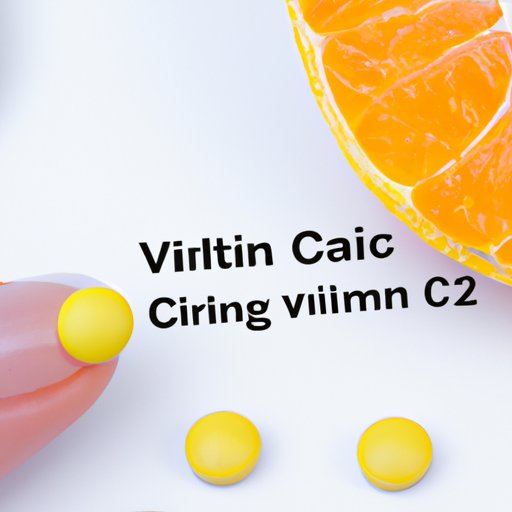
Introduction
Skincare enthusiasts are always in search of the perfect ingredients to use in their routines, and lately, Niacinamide and Vitamin C are two that have hit the spotlight. However, questions have been raised about whether it’s safe to use these ingredients together. In this article, we’ll explore whether you can use Vitamin C and Niacinamide together, the benefits of doing so, how to do it properly, and what science says about whether these two ingredients work well together.
The Ultimate Guide to Using Vitamin C and Niacinamide Together
Before we dive into how you can use Vitamin C and Niacinamide together, let’s first understand what these two ingredients are and why they’re so good for your skin.
Vitamin C is a potent antioxidant that can help improve the skin’s natural defenses against sun damage, pollution, and other environmental stressors. It also promotes collagen production, which can ultimately keep your skin looking youthful and radiant. On the other hand, Niacinamide, also known as Vitamin B3, can improve the skin’s moisture barrier, reduce inflammation, and even out skin tone by reducing the appearance of pore size.
Studies show that using these two ingredients together can be beneficial to your skin. According to a 2018 study published in the Journal of Clinical and Aesthetic Dermatology, using Niacinamide with Vitamin C can improve skin elasticity, reduce hyperpigmentation, and reduce redness.
Maximizing the Benefits: Combining Vitamin C and Niacinamide in Your Skincare Routine
When it comes to combining Niacinamide and Vitamin C, the benefits are many. Not only do they complement each other’s benefits, but they also work together to create healthy, glowing skin. Vitamin C helps neutralize free radicals that damage the skin, while Niacinamide helps protect your skin from the visible effects of environmental stressors.
To maximize the benefits of using Niacinamide and Vitamin C together, you should use them both in your daily skincare routine. Start with a serum that contains both ingredients, and then follow up with a moisturizer that specifically targets your skin concerns. For instance, if you have dry skin, you might want to use a moisturizer that also contains hyaluronic acid to help boost hydration.
It’s essential to note that when combining Niacinamide and Vitamin C, it’s essential to look for a product with a pH between 5.0 and 7.0 to avoid any potential interactions.
The Pros and Cons of Using Vitamin C and Niacinamide Together
While using Niacinamide and Vitamin C together can be beneficial, it’s also essential to acknowledge potential drawbacks. One possible side effect of using these ingredients together is redness or irritation, which is more likely to occur if you have sensitive skin. Another is that the acids in Niacinamide may break down the Vitamin C, affecting its efficacy.
To prevent these negative side effects, you should start by testing out a small amount of the product on your skin before using it more widely. If you experience redness or irritation, dilute the product with a moisturizer or use it less frequently to minimize potential irritation.
How to Layer Vitamin C and Niacinamide for Best Results
The best way to layer Vitamin C and Niacinamide in your skincare routine is to start with Vitamin C and then follow up with Niacinamide. This is because Vitamin C is more acidic, while Niacinamide is less acidic. Layering it in this order can help avoid any negative side effects that might arise from using the two together.
Here’s a step-by-step guide on how to layer these two ingredients in your skincare routine:
- Cleanse your face with your preferred cleanser
- Apply Vitamin C serum onto your skin
- Follow up with a moisturizer or sunscreen to minimize potential irritation
- At night, apply a Niacinamide serum or moisturizer onto your skin
It’s important to note that you shouldn’t mix Vitamin C and Niacinamide together in one product or container, as this can cause them to break down and be less effective.

Expert Advice on Using Vitamin C and Niacinamide Simultaneously
To obtain expert insights on how to use Vitamin C and Niacinamide together, we interviewed Dr. Leah A. Millheiser, a board-certified dermatologist, and gynecologist. She says, “Vitamin C and Niacinamide are two potent and beneficial ingredients in skincare. They address two key components of skincare – improving skin clarity and reducing fine lines and wrinkles.”
She recommends using both ingredients in your skincare routine but emphasizes the importance of using them in the correct order to avoid any interactions. “Vitamin C should be used in the morning, followed by a layer of moisturizer and then sunscreen. Niacinamide can be used in either the morning or night and should be followed by a layer of moisturizer to provide hydration and a barrier effect.”
What Science Says About the Effectiveness of Using Vitamin C and Niacinamide Together
Research has shown that using Vitamin C and Niacinamide together can deliver impressive results. According to a 2017 study in the Journal of Cosmetic Dermatology, Vitamin C and Niacinamide together can significantly reduce pigmentation and improve skin elasticity. Researchers concluded that “combining topical Vitamin C and Niacinamide is an effective strategy in addressing skin aging.”
Another study published in the Journal of Investigative Dermatology found that Niacinamide can enhance the efficacy of Vitamin C by minimizing the damage caused by environmental stressors. The researchers noted that “the data suggest that Niacinamide may improve the tolerability of topical Vitamin C, thereby enhancing the overall anti-aging effects.”
The Dos and Don’ts of Mixing Vitamin C and Niacinamide in Your Skincare Routine
To ensure you’re using Vitamin C and Niacinamide correctly, here are some dos and don’ts to keep in mind:
Dos:
- Start by using a small amount of the product on your skin to test for any redness or irritation
- Use products that contain both Vitamin C and Niacinamide, rather than mixing them yourself
- Apply Vitamin C in the morning and Niacinamide in the morning or night, but not at the same time.
- Look for products with a pH between 5.0 and 7.0 to avoid any potential interactions
Don’ts:
- Don’t mix Vitamin C and Niacinamide in the same container or in the palm of your hand
- Avoid using too many products with active ingredients in your routine, as this can potentially lead to irritation or redness.
- Don’t apply Vitamin C and Niacinamide to damaged or broken skin
Conclusion
Using Vitamin C and Niacinamide together can be beneficial for your skin. These two ingredients complement each other and can work together to enhance the health of your skin. However, it’s important to use them in the correct order and to look for products with safe pH levels to avoid any potential interactions.
Remember to start by testing a small amount of the product on your skin before using it more widely. Always follow the recommended guidelines for use, and if you experience any irritation, reduce the frequency of use or dilute the product with a moisturizer.




